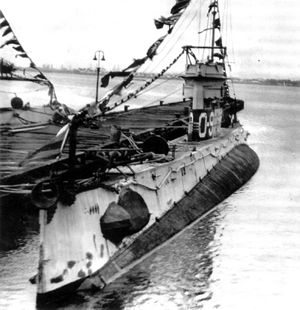
Presentation Title: The Search for the Submarine USS O-9
Speaker: Dr. David Switzer, Plymouth State University
When: Thursday, October 29, 2009, at 7:00 pm
Where: Anastasia Gallery (upstairs Keeper’s House), St. Augustine Lighthouse & Museum
Come join LAMP research associate Dr. David Switzer as he shares the story of a NOAA expedition in search of a lost submarine and answers to an unsolved U.S. Navy mystery! The United States submarine USS O-9 was launched at Quincy, Massachusetts in 1918 to serve in World War I. She never saw war service but conducted cruises off the Canal Zone in the 1920s. She was decommissioned in 1931 and ten years later as the clouds of war were darkening Europe she was recommissioned. Her new life was to serve as a “training boat” out of New London, Connecticut. But first it was necessary that the USS O-9 and others of the class take a deep submergence test.
USS O-9 and USS O-8 arrived at the Portsmouth Naval Base in New Hampshire in June 1941; the USS O-8’s submergence took place near the Isles of Shoals eight miles out at a depth of 200′. On the following day USS O-9 headed into the Gulf of Maine submarine operating area and performed her test at a depth of 400′. USS O-9 did not surface nor send a message. An oil slick and flotsam soon indicated that the USS O-9 could do neither. Navy divers descended to the hull in extreme conditions and found no sign of life.
There had been a similar situation in 1939 when the USS Squalus could not surface because of a problem with an induction valve. Unlike USS O-9, Squalus was accessible to divers who were able to attach a newly invented rescue chamber over a hatch making the rescue of a number of crewmen possible.
In 1997 by means of sonar, the wreck of USS O-9 was located and found sitting upright on the seabed. A NOAA team relocated the site in 2004 using the Research Vessel Connecticut. Also participating were representatives of the Naval Historical Center, the National Undersea Research Center, and the Marine Studies Program at UCONN.
State nautical archaeologists David Switzer (New Hampshire) and Victor Mastone (Massachusetts) were invited as observers of the archaeological “forensic” study to find the answers as to what caused USS O-9’s catastrophic failure. The presentation will trace the history of the fated submarine, the relocation and survey, and the reasons that USS O-9 failed her deep submergence test.
UPDATE: I have changed the vessel name from “SS 09” to “USS O-9,” which according to submariner Jim Christley is the proper form. Thanks to Mr. Christley for bringing this to our attention in the comments section below!
About the Speaker: Dr. David Switzer is the Consulting Nautical Archaeologist for the state of New Hampshire and has semi-retired after a 39 year career as a professor of history at Plymouth State University. He is a LAMP research associate who has participated in LAMP fieldwork in St. Augustine and has lectured at LAMP field schools, and has presented a number of times at the St. Augustine Lighthouse & Museum. Dr. Switzer is a true pioneer in the field of maritime archaeology and has directed a number of well-known research projects, including the excavation of a 17th century shallop, the hull recovery of the 19th century clipper ship Snow Squall, and the excavation of Revolutionary War privateer Defence.

